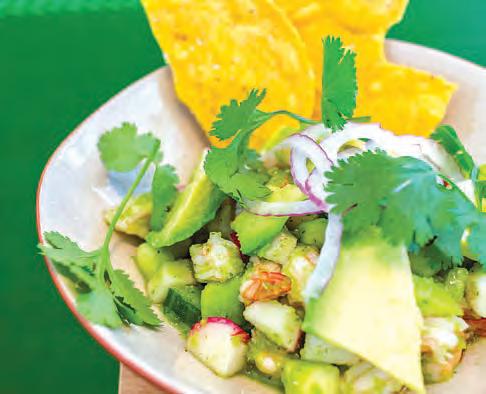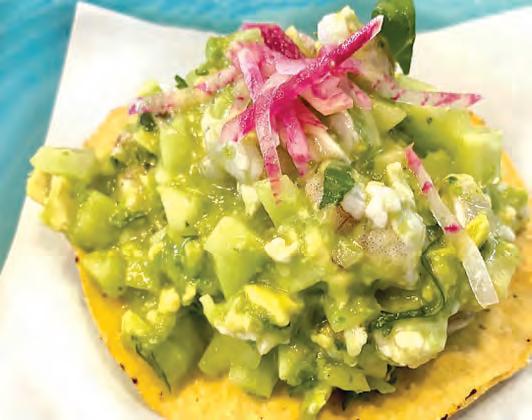
6 minute read
COVER STORY—A Fresh Spin on Ceviche
A Fresh Spin On Ceviche
Xico’s Ceviche Verde

Claro’s ceviche packaged for delivery

| BY KATHLEEN FURORE | In an August 1 email Xico restaurant in Portland, Oregon sent about the day’s takeout and delivery menu, Ceviche Verde led the list of available options. For $17, customers could order a ½ pint of ceviche made with fresh, local, wild, red banded rockfish in lime juice with green herbs, avocado, cucumber, olive oil and a small bag of chips—enough for two people or a meal for one. “Order by noon, have it tonight!” the subject line promised.
That the ceviche was the first item on the list (which also included “Oaxaca Salads, Car nitas, Guac, Esquites, Burritos, Rotis Chicken”) speaks to t h e popularity of this dish typically made from fresh raw fish cur ed in fr esh citrus juices.
It also dovetails with recent data about diners’ penchant for seafood: Nielsen reports that sales of fresh seafood at retail spiked nearly 60 percent to near ly $163 million for the week ending June 27, while Alaska Seafood Marketing Institute stats show that seafood was the secondmost missed item for consumers who couldn’t eat in r estaurants during the pandemic.
And while COVID-19 stalled seafood sales at r estaurants, seafood has become the fastest growing category at supermar kets and food outlets featuring online sales and pickup or deliver y ser vices, a report from Alaska Fish Radio/ Alaska Com mercial Fisheries News says.
SWIMMING WITH OPTIONS Ceviche’s versatility makes it an ideal menu addition for most any Mexican and Latin restaurant. • It can be made with many types of fish and seafood.
Firm or semi-firm fish like sea bass that won’t fall apart in the acid of the citrus juice, shellfish like shrimp and scal lops, and squid are a few options. The secret to success?
“Fr eshness is the most important thing. All of my memories [of eating ceviche] ar e fr om be
–ALASKA SEAFOOD MARKETING INSTITUTE
Baja Lounge’s Green Ceviche Shrimp Tostada
Seafood has become the fastest growing category at supermarkets and food outlets featuring online sales and pickup or delivery services.
–ALASKA FISH RADIO/ ALASKA COMMERCIAL FISHERIES NEWS

ing in Mexico and using whatever people were pulling out of the water,” says T .J. Steele, executive chef/owner of Claro in Brooklyn, New York, who relies on the local, in-season catch for his ceviche menu. For now, that means tilefish, sea bass and day boat scal lops from Montauk. “That way , you should be getting the best prices,” he says, not ing that appr oach works only “if your customers trust you and don’t demand things like salmon when it’ s off-season.” • It works well for restau
rants at most any price
point. Ceviche is found everywhere from beachside taquerias to more upscale concepts. You can serve it in plastic cups accompa nied by crackers or chips; atop crisp tostadas or stacked in color ful towers like the Especial Torres

featuring ceviche with shrimp, octopus, scallops, avocado and a special house sauce at Baja Lounge in Chula Vista, California; or creatively plated like the Ceviche Sampler starring Peruvian, Mexican, and Avocado & Mahi at Stir in Raleigh, North Carolina. The Peruvian Ceviche features corvina, red onions, sweet potatoes and tiger’ s milk; the Mexican Ceviche includes citrus cured mahi, shrimp, avocado, salsa and cotija; and the Avocado & Mahi Ceviche is made with (continued on p. 18)
Aguachile—which translates to “chile water”—is a version of ceviche usually made with shrimp.
But as Jim Peyton of Lo Mexicano Consulting notes, “It usually consists of very fresh, raw shrimp laid on a plate and bathed with a pureed mixture of lime juice, chile and salt…Since finding shrimp of the proper freshness (sashimi quality) is often difficult, I tried making the dish with perfectly fresh fish. The result was terrific!”
Like traditional Peruvian-style ceviches, aguachile is cured in citrus juices. The difference? “The acidity is toned back in favor of commanding green-chile heat, and salted vegetables like cucumbers and onions contribute a potent yet watery broth of sorts for the shrimp to bathe in,” an article by food writer Max Falkowitz at tastecooking.com explains.

Baja Lounge’s Mango Aguachile

mahi, avocado, red onions, sweet potatoes, and green tiger’s milk. • It is appropriate for takeout and delivery menus. This is an especially important con sideration during these uncertain times. Steele—whose ceviches ar e among the top sellers he’s been dishing out during the pandemic—says keeping ceviches cold and packaged apart from hot food is important for delivery and carryout service. (For more about optimizing your delivery menu, see story on page 19.)
At Baja Lounge, freshness is paramount—especially because the restaurant had to revert to delivery and carryout only when COVID-19 cases star ted to peak again Califor nia.
“We don’t make one big batch of ceviche for the whole day—we are very care ful with the fish and make each order individually so it is always as fresh as possi ble,” says Robert, a member of the kitchen staff overseeing food pr ep, who says ceviches is selling well during the dining-in shut-down. • It can be adapted to appeal to vegan customers . No fish or shellfish, you say? That’s right! Think heart of palm, cauliflower and coconut instead of fish and seafood to appeal to vegan and vegetarian customers. (See sidebar below.)
Kathleen Furore is the editor of el Restaurante
Make It Vegan!
In February 2019, a new booth called “Veggie Veggie Fruit Fruit” debuted at the Disney California Adventure Food & Wine Festival in the Disneyland Resort in Anaheim, California. The menu—designed for visitors looking for healthy, vegetarian and vegan fare—included Cauliflower Ceviche with Chile Corn Crumble and Tortilla Chips.
Vegan ceviche, of course, isn’t new to Mexican menus. La Vegan Mexicana in Santa Ana, California, for example, offers tostadas topped with ceviche made of cauliflower, cucumber, tomato, purple onion, cilantro, salt, lime and

Jocelyn Ramirez’s Ceviche de Palmitas PHOTO BY ZOHRA BANON; REPRINTED WITH PERMISSION FROM LA VIDA VERDE spices, and Borracha Mexican restaurant in Henderson, Nevada has touted a vegan coconut ceviche made with a coconut serrano dressing and served with crispy plantains on its website. But its appearance at such a mainstream venue shows its time has arrived.
Jocelyn Ramirez, the chef/founder of Los Angeles-based catering company Todo Verde and author of La Vida Verde: Plant-based Mexican Cooking with Authentic Flavor, not only agrees that plant-based Mexican food has arrived; as she says in her recently released cookbook: “I believe that plant-based Mexican food is both the past and the future of Mexican food culture.”
While she has traveled a “labyrinth of a journey” on the road to following a plant-based diet, she’s arrived. Says Ramirez: “I was once freaked out by the idea of eating a meal without meat, but now I find a satisfying comfort in recipes that challenge my palate to explore a bit further…”
It’s something she does with dishes like her Ceviche de Palmitas made with heart of palm “because it has a core texture similar to crabmeat,” she explains. The ceviche is made with palmitas marinated in lemon and olive oil paired with tomato, avocado, cucumber and jalapeño, then topped with black sesame seeds and cilantro.
You can find Ramirez’s Ceviche de Palmitas recipe on page 43.
La Vegan Mexicana’s Cauliflower Ceviche Tostada









